MyDigitalSSD SMART & BP3 mSATA SSD Review
by Kristian Vättö on January 22, 2013 1:24 PM ESTMyDigitalSSD SMART
The heart of the SMART is SandForce's SF-2281 controller, which is used by dozens of manufacturers. SandForce doesn't use dedicated DRAM cache, leaving the controller and NAND as the only components on the PCB. The drive came with firmware 5.0.2a but there's a newer 5.0.4 available at MyDigitalSSD's website. I ran a few tests with the new firmware but didn't see any noticeable difference in performance so the scores you'll see are with the 5.0.2a firmware.
On the flip side we find another two NAND packages. These are all octo-die packages to yield the capacity of 256GB, which is currently the maximum for mSATA form factor (though Mushkin has announced a stacked mSATA design with up to 480GB). Once 128Gb dies start to make their way into the market sometime in 2013, we should see mSATA SSDs of up to 512GB without special designs.
The actual NAND in the SMART is a bit of a mystery. Googling the part number yields no results but from what I was able to find, it seems that the NAND is running in synchronous mode and manufactured using IMFT's 25nm process but packaged by ADATA (for example their SX300 uses the same NAND). The idea is that you buy whole wafers of NAND and then use your own binning methodology to pick the best dies. When you buy pre-packaged NAND, it's unlikely that you'll be getting the highest quality NAND because usually the manufacturer reserves that NAND for their own products. If you buy NAND in whole wafers, you will also get a small share of the highest quality chips, although you are also left with a big chunk of NAND that is not suitable for SSDs (but it may be fine for memory sticks and cards). This is a fairly common practice in the SSD industry and for example OCZ and Kingston do it as well.
It's unclear to me why MyDigitalSSD chose ADATA but the SMART is actually recognized as an ADATA SX300 by the system, so the SMART may be a rebrand of the SX300 or at least MyDigitalSSD has worked very closely with ADATA.
MyDigitalSSD BP3
Not much is known about Phison's PS3108 controller. Phison says the controller supports both SLC and MLC NAND, along with 1Xnm class NAND. The controller is fabricated using 55nm CMOS process, but the actual manufacturer is unknown. The controller is coupled with 256MB of DDR3-1333 DRAM from Nanya. The drive came with firmware version 3.2, which is currently the latest.
In the NAND department we have four of Toshiba's 24nm Togge-Mode MLC NAND packages, each consisting of eight 8GB dies yielding a total capacity of 64GB per package.
The motherboard in my testbed does not have an mSATA slot, so MyDigitalSSD also sent us an mSATA to 2.5" SATA adapter.
Test System
| CPU | Intel Core i5-2500K running at 3.3GHz (Turbo and EIST enabled) |
| Motherboard | AsRock Z68 Pro3 |
| Chipset | Intel Z68 |
| Chipset Drivers | Intel 9.1.1.1015 + Intel RST 10.2 |
| Memory | G.Skill RipjawsX DDR3-1600 2 x 4GB (9-9-9-24) |
| Video Card |
XFX AMD Radeon HD 6850 XXX (800MHz core clock; 4.2GHz GDDR5 effective) |
| Video Drivers | AMD Catalyst 10.1 |
| Desktop Resolution | 1920 x 1080 |
| OS | Windows 7 x64 |


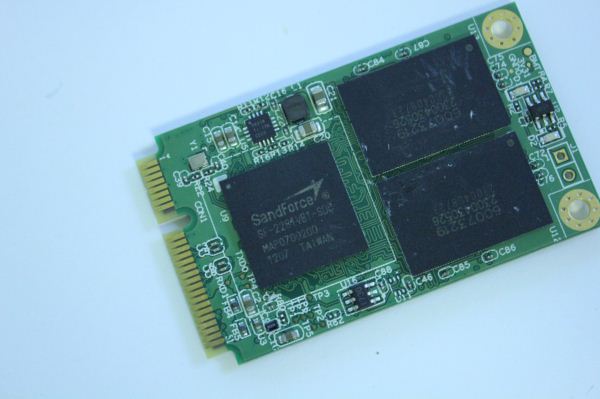
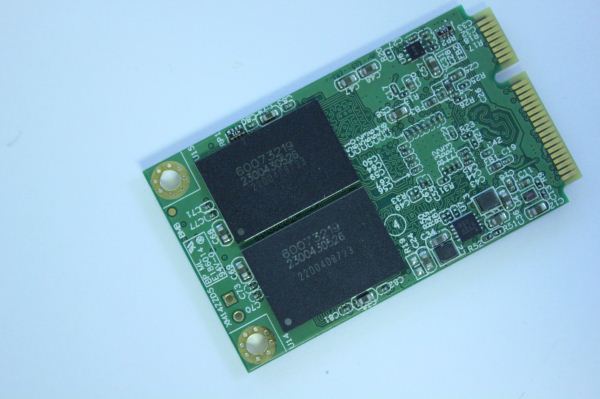
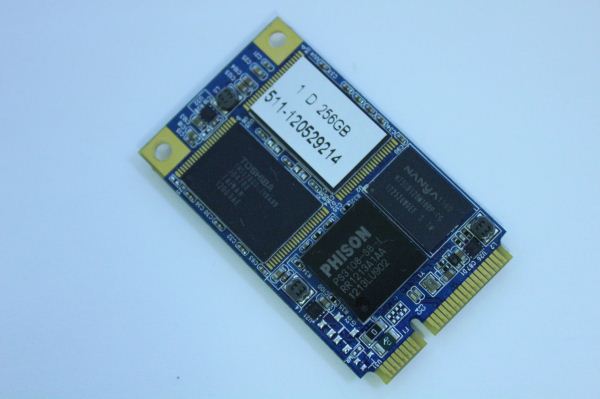
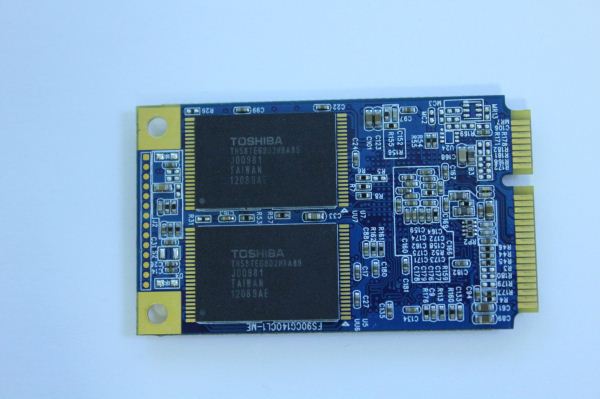
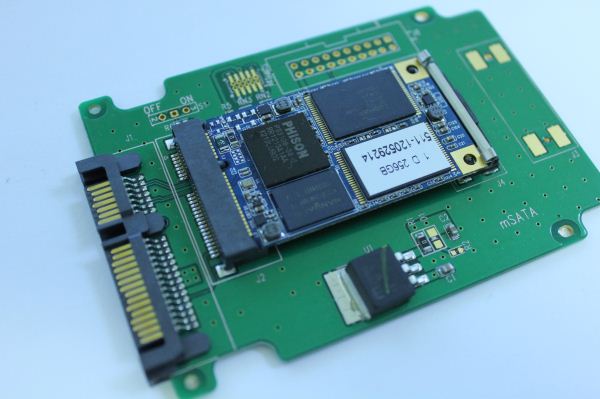








49 Comments
View All Comments
ssj3gohan - Tuesday, January 22, 2013 - link
Aside from my usual remarks on using the wrong methodology for idle power consumption (use a DIPM-enabled testbench!), the mSATA slot uses 3.3/1.8V, while your 2,5" adapter provides this power from 5V via an LDO. LDOs are power converters that step down voltage linearly, i.e. 5V 1A in -> 3.3V 1A out (current is conserved), contrary to switching converters that, apart from efficiency losses, try to do this conversion losslessly.This means that when you measured 5V 0.1A for the BP3, the actual drive consumed 3.3V 0.1A, i.e. 0.33W instead of 0.50W.
magao - Tuesday, January 22, 2013 - link
I recently bought a new notebook specifically because it had an mSATA slot. It came pre-populated with a 32GB cache drive and 500GB hard drive.I immediately replaced it with a 1TB drive and the largest mSATA SSD I could get (128GB OCZ Nocti). I put the OS on the hard drive, then configured the SSD as 32GB cache, the rest (~80GB usable) as data.
The stuff I use all the time was then installed onto the SSD (source code repositories, etc). Lots of small files -> SSD.
The OS + 16GB hibernate file are on the hard drive, which means that's space not being taken up on the limited SSD space. Instead the 32GB cache (which is about the same size as the OS + hibernate file combined) ensures the most-used blocks on the hard drive are cached. Of couse, the page file is on the SSD.
Writes to the hard drive are largely sequential as the caching essentially does write-combining.
I've used symlinks to move various settings to the SSD e.g. web browser cache, etc.
I periodically use Resource Manager to check disk activity. There is some write activity to the hard drive, but it's pretty minimal. Right this instance there are only 5 files listed as either reads or writes to the hard drive. I almost never notice that the hard drive is in use - nearly everything performs at SSD speeds.
Would I prefer to have an all-SSD system? Sure? Can I afford it? Well, I could, but I can get better bang for my buck by using the setup above, with very similar results.
tk11 - Tuesday, January 22, 2013 - link
I recently bought one for a Lenovo x230 that I chose in part because it featured an empty mSATA slot. For anyone willing to take the time to install a mSATA SSD for use as the system drive it's a very compelling feature.magnusoverli - Tuesday, January 22, 2013 - link
Hello.First post at AnandTech... :-)
You say that you cannot see why any desktop users would adopt the mSata-standard, and although I can see that it was not initially meant to be a perfect match, I think it may be. It all depends of course on the individual users´ needs and other hardware.
I recently built a new server for multimedia streaming and backup purposes, and went for the ASUS Maximus V Gene mobo. It enables me to have the OS on an "onboard" msata-slot, and leaving all sata slots for data drives. This is, for me, the perfect combination of performance and flexibility.
I can see that others have commented and touched on related topics, but just wanted to let you know that desktop/server-systems and msata really is a beautiful thing!
M
JarredWalton - Tuesday, January 22, 2013 - link
Except, as noted above, mSATA is set to be replaced by M.2 this year. That's where more SSDs and motherboards are likely to head in the future.magnusoverli - Tuesday, January 22, 2013 - link
Granted that msata is a standard that is about to fade out, isn´t that the reality for just about any standard that has become, or is about to become, mainstream.Also, how long does it take before a new standard is introduced, before it is ready for the main stage? There are only a very few users standing by being ready to upgrade when the first products hits the shelves.
Also, I think that one should maximize the usage of current technologies (within budget) and not stay on the side-lines, always waiting for the next big thing.
But, hey.. That´s just me! ;-)
Death666Angel - Wednesday, January 23, 2013 - link
DDR1/2/3, DVI/HDMI/DP, SATA 1 through 3, USB 1 through 3.All the important standards are either very long lived (5 years for DDR3 now) or are backwards compatible or can be easily used with simple adapters. That is not the case with mSATA. It was niche to begin with, it stayed niche even when there was a big demand for fast, small storage in ultrabooks and tablets and now it is being phased out.
Kristian Vättö - Wednesday, January 23, 2013 - link
But can you use the six SATA headers on the motherboard simultaneously with the mSATA slot? The fact is, mSATA does not add SATA connectivity, it takes one port just like a regular SATA port on the mobo does. It's of course possible that there is a third party SATA controller that provides a few extra ports but those exist without mSATA as well.Not trying to belittle mSATA and the comments here have been mind-opening, I seriously hadn't heard that people actually use mSATA SSD in desktops. Sure I've seen a few but it's good to heat that mSATA SSDs aren't just decorations.
iwod - Tuesday, January 22, 2013 - link
Assuming SATA Express will bring us performance of Today's top SSD in RAID, which still isn't fast enough for Apps to pop out, Startup and Shutdown to be less then 2 seconds,is software the limitation now? Or we need faster CPU?
Zink - Tuesday, January 22, 2013 - link
I'm running a mSATA drive from Adata in my Lenovo laptop and I love being able to pull the optical drive and run three drives in a normal laptop. Boot drive + data drive + hotswap drive for temporary projects.